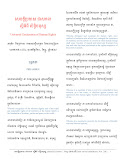By Michelle Vachon - October 15, 2012
The Cambodia Daily
Retired King Norodom Sihanouk, whose name for half a century was synonymous with Cambodia on the world stage, died in the early hours of Monday morning in Beijing.
The former monarch, who was about to celebrate his 90th birthday on October 31, died peacefully in a Beijing hospital at 1:25 a.m. Cambodia time, an official in Norodom Sihanouk’s inner circle confirmed from Beijing two hours after the death.
“The Royal Government of Cambodia will bring the King-Father’s body back to Cambodia for a traditional royal funeral,” the Council of Ministers said in a statement later in the morning.
Prince Sisowath Thomico, chief of cabinet for the late King Father, said that Norodom Sihanouk had suffered a heart attack.
“His heart was very weak, so we were expecting this to happen, but we were just surprised that it happened so fast,” Prince Thomico said.
He said Royal Palace officials had told him King Sihamoni, Prime Minister Hun Sen, Deputy Prime Minister Sar Kheng and Say Chhum, head of the ruling CPP’s standing committee, flew to Beijing on a special flight at around 9:30 a.m. this morning.
“His Majesty the King and Prime Minister Hun Sen went to Beijing this morning, and maybe they will come back with the body,” Prince Thomico said, adding that arrangements for Norodom Sihanouk’s body to be returned to Cambodia had not yet been made.
After stepping down from the throne in 2004 to pave the way for his successor and son, King Norodom Sihamoni, the retired King was dubbed “King Father” by his people, whom he had always called “my grandchildren” in Khmer and “mes enfants” in French.
Though Norodom Sihanouk’s health had been a concern for many years – he was treated for prostate cancer in the mid-1990s and had remained under medical supervision ever since—he was still busy giving audiences up until last month.
After his abdication in 2004, Norodom Sihanouk spent most of his time in Beijing under the medical care of a team of Chinese doctors who also accompanied him during his visits to Cambodia. But his health did not prevent him from pursuing an active life and he continued to write open letters on his website. Although he spent most of his time in Beijing for health reasons, the King Father was always fully aware of events and the situation in the country.
After re-ascending to the throne following the 1993 U.N.-sponsored elections, Norodom Sihanouk was—as he often pointed out—a constitutional monarch who reigned but did not rule. Still, through his moral authority—and often acerbic comments on Cambodia’s political figures and issues—he continued to play a major role in Cambodian public life until his retirement and even afterwards.
In spite of his repeated appeals to remove his portrait from public buildings and only display his son’s, Norodom Sihanouk’s portrait and the portrait of his wife, Queen Mother Monineath, still appear next to King Sihamoni’s picture in most government and public buildings throughout the country.
Born on October 31, 1922, the retired King was crowned in May 1941 while the country was still administered by France. In a bold gesture—the first of many in his long, storied career—Norodom Sihanouk declared Cambodia’s independence in 1945 following the arrest of all Frenchmen in the country by the Japanese military then controlling Cambodia.
After Japan’s defeat in World War II, Norodom Sihanouk had to relinquish political control when the French returned. But far from giving up, he obtained the country’s independence peacefully from France in 1953 after using a series of tactics that included trips to Paris, Canada, the U.S. and Japan to gain international political and media support for his call for Cambodia’s freedom from colonial rule, a movement he dubbed the “Royal Crusade.”
In 1955, Norodom Sihanouk abdicated the King’s throne in order to become directly involved in the politics of the country. As Prince Sihanouk, he founded the political party Sangkum Reastr Niyum and, by 1960, he ruled the country as chief of state and head of the country’s sole political party.
Though he attempted to walk a tightrope between the competing Cold War powers of East and West, Cambodia was dragged into the second Indochina conflict in the late 1960s as the war in neighboring Vietnam spread across his country’s borders.
Ousted by the pro-U.S. military government of General Lon Nol in March 1970, Norodom Sihanouk took refuge in Beijing where he received Chinese government support for his efforts to defeat Lon Nol and return to power.
The King’s maquis, however, was subverted by the nascent Khmer Rouge movement, which took power in 1975.
During the Khmer Rouge regime, which was also backed by China, Norodom Sihanouk, Queen Mother Monineath and then-Prince Sihamoni remained under house arrest at the Royal Palace in Phnom Penh. Many other members of the royal family were executed and disappeared during those years.
After the Khmer Rouge defeat in 1979, Norodom Sihanouk returned to China and worked at building a broad coalition of resistance against the Vietnamese presence in Cambodia. He later headed the coalition of Cambodian political factions that negotiated and signed the Paris Peace Agreement in October 1991.
Following the U.N.-backed 1993 national elections and the adoption of the Constitution, Norodom Sihanouk became the country’s King for the second time in his life and continued to exert considerable influence on the social and political landscape.
He was never one to shy from controversial issues, such as political violence, corruption or border issue with Vietnam and Thailand, and at times he directly intervened, such as in the aftermaths of the 1997 factional fighting that saw the ousting of his son and then-First Prime Minister Prince Norodom Ranariddh by then-Second Prime Minister Hun Sen. He also convened meetings in the Royal Palace of senior party leaders in an attempt to break the political deadlock that paralyzed the government for one year following the 2003 national elections.
(Additional reporting by Simon Lewis)









+07.jpg)
















5 comments:
Oh!.. My dearest my King.
You will be missed immensely., I have been always respected to the King. I can’t wait to attend the funeral procession of the King.
former KR soldier
Si jamais je pouvais vous détester pour avoir détruit notre mère patrie!!!
Passer-By
Ah Asshole 3:25 AM,
Would you write in English? Ah? Get your ass out of here. Your godham French is so terrible to understand.
former KR
The French betrayed the real king Monireth, the fake king shithonock betrayed the French, Lon nol betrayed the Shithonock, US betrayed Lon Nol, Vietminh betrayed Sithonock and Pol Pot, Chinese betrayed the Vietminh etc 'what goes around comes around and what you do is what you get'.
Ater French trained Sithanock to become a good ruler, Sithanock then turned the French, it was like looking after a crocodile 'ka per og veag bog' in khmer language.
Burn his body over there (China). Don't bring back to Cambodia. He was a Traitor to Khmer people. The Khmer people have suffered enough by him. He did not respect even his own mother. He was an evil king . He should be alive until he can serve his punishement in the Khmer Rouge trail. Please don't forget he was the person who killed Lok Protean Sam Rainsy's father.
Pang Sokheoun, Secretary-General of SRP in Sweden.កុលបុត្រមហានគរខ្មែរ
Post a Comment